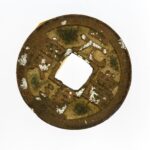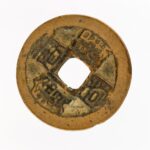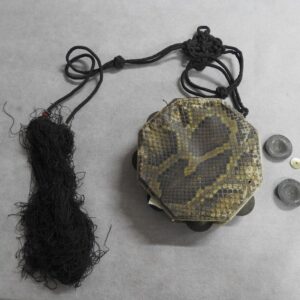Coin Yuanfeng tongbao
A round copper alloy coin with a square hole in the centre, called fangkong qian 方孔錢. These appeared in various denominations, mostly as tongbao 通寶 (“common currency”) coins, which were worth one monetary unit, yuanbao 元寶 (“original currency”) and zhongbao 重寶 (“heavy currency”) which had higher denominations. In many varieties and denominations, such coins had been in circulation as standard money since the time of Emperor Gaozu 高祖 (reigned 618–626), the first emperor of the Tang Dynasty (618–907) until the end of the Qing Dynasty (1644–1912). The inscription on the coin usually consists of two characters, reading from top to bottom, indicating the name of the reign or the period in which the coin was minted. The other two characters are to be read from right to left. On the left-hand side of the coin is usually the character bao 寶 (wealth, preciousness), which in combination ... more
A round copper alloy coin with a square hole in the centre, called fangkong qian 方孔錢. These appeared in various denominations, mostly as tongbao 通寶 (“common currency”) coins, which were worth one monetary unit, yuanbao 元寶 (“original currency”) and zhongbao 重寶 (“heavy currency”) which had higher denominations. In many varieties and denominations, such coins had been in circulation as standard money since the time of Emperor Gaozu 高祖 (reigned 618–626), the first emperor of the Tang Dynasty (618–907) until the end of the Qing Dynasty (1644–1912). The inscription on the coin usually consists of two characters, reading from top to bottom, indicating the name of the reign or the period in which the coin was minted. The other two characters are to be read from right to left. On the left-hand side of the coin is usually the character bao 寶 (wealth, preciousness), which in combination with the character on the right means “currency” or “money in circulation”. This is usually the character tong 通 (circulate, be uniform, general or universal), but often alsoyuan 元 (origin, basis) or zhong 重 (weight), which usually denote coins with a larger face value. Thus, the entire inscription literally means “money in circulation at the time of this or that emperor” or “in this or that period of a single emperor’s reign”.
Coins from the Song Dynasty (960–1279) are special because the writing in four characters on the front of the coin is sometimes to be read clockwise, from the top character to the character on the left-hand side of the coin. Moreover, whereas the coins of all earlier and later dynasties were usually minted under the same title throughout the reign of a particular emperor, it was common for Song Dynasty emperors to issue several types of coins during their reigns, named after the different periods of their rule. During the time of the emperors of the Northern Song Dynasty (960–1127) in particular, the same type of coin was often minted with inscriptions in different fonts or calligraphic styles. In addition to the standard kaishu 楷書 script, the seal script or zhuanshu 篆書, the “official script” or lishu 隸書, the cursive or “flowing script” xingshu 行書 and the “grass script” caoshu 草書 were also used. With their peculiarities and the artistry of the inscription, the coins of this period even have a kind of artistic value, so it is not surprising that they are highly valued and sought after by collectors and connoisseurs of Chinese money.
The coin in the photo is the so-called Yuanfeng tongbao 元豐通寶, which reads clockwise and has characters written on the obverse in the elaborate “official script” or lishu 隸書. It was minted during the reign of Emperor Shenzong 神宗 (1068–1085), in the period of his reign called Yuanfeng 元豐 (1078–1085), which means “beginning of abundance”. (MG)





































Do you have a comment or additional information about the subject?